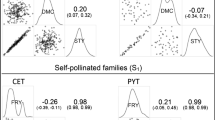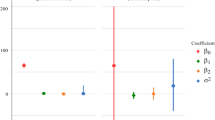Abstract
In perennial crops like coffee, genetic improvement efficiency is limited by several factors. These include determining the acceptable minimum observation period for yield traits, and also variation of the traits over time, in order to develop breeding objectives that incorporate stability and persistence of the desired traits. Yield data from a trial comparing 20 Coffea canephora clones in Ivory Coast, monitored over nine production years, were analyzed by two different methods. (1) After studying genetic correlations between yields in successive years, longitudinal data analyses were applied to understand relationships between years. Several models were tested and the Compound Symmetry model, with heterogeneous variances (CSH model), best described the data structure. For instance, at tree level, correlations between yields of the different years were moderately stable, which revealed a major tree effect within clones. (2) Subsequently, derived index traits were considered, characterizing yield distribution over the different years. The traits involved were earliness, alternation, and the intensity of variations between years. Despite a marked tendency towards biennial cropping, especially in the early years, the estimated genetic correlations between years, and between individual years and cumulative yield were generally high. The intensity of the relative differences between yields in successive years was heritable only in the second production cycle. Despite some clonal differences in yield-stability variables, clonal yields in single years or groups of years evidently reflected both cumulative yields and comparative yield stability.
Similar content being viewed by others
References
Agresti A, Coull BA (1998) Approximate is better than “Exact” for interval estimation of binomial proportions. Am Stat 52:119–126
Amoah FM, Osei-Bonsu K, Oppong FK (1997) The effect of shade, stem number and spacing on robusta coffee yield in Ghana. In: 17th International conference on coffee science, Nairobi, Kenya, 20-25 July 1997. ASIC, Paris, pp. 528–534
Apiolaza LA, Gilmour AR, Garrick DJ (2000) Variance modelling of longitudinal height data from a Pinus radiata progeny test. Can J For Res 30:645–654
Becker HC, Léon J (1988) Stability analysis in plant breeding. Plant Breed 101:1–23
Berthaud J, Charrier A, Guillaumet JL, Lourd M (1984) Les caféiers. In: Pernes J (ed) Gestion des ressources génétiques des plantes. Tome 1: Monographies J, pp. 45–104
Cannell MGR (1985) Physiology of the coffee crop. In: Clifford M, Willson K (eds) Coffee: Botany, Biochemistry and Production of Beans and Beverage. Croom Helm, Ltd, London, pp 108–134
Cestac Y, Snoeck J (1982) Les essais de densité, de dispositifs de plantation et de taille sur les caféiers Robusta en Côte d'Ivoire. Résultats et perspectives. Café Cacao Thé 26:183–198
Cilas C, Bouharmont P, Boccara M, Eskes AB, Baradat Ph (1998) Prediction of genetic value for coffee production in Coffea arabica from a half-diallel with lines and hybrids. Euphytica 104:49–59
Cilas C, Bouharmont P, Bar-Hen A (2003) Yield stability in Coffea canephora from diallel mating designs monitored for 14 years. Heredity 91:528–532
Cilas C, Bar-Hen A, Montagnon C, Godin C (2006) Definition of architectural ideotypes for good yield capacity in Coffea canephora. Ann Bot 97:405–411
Coste R (1989) Caféiers et cafés. Ed. Maisonneuve et Larose, Paris, France
DaMatta FM, Loos RA, Silva EA, Loureiro ME (2002) Limitations to photosynthesis in Coffea canephora as a result of nitrogen and water availability. J Plant Physiol 159:975–981
DaMatta FM, Chaves ARM, Pinheiro HA, Ducatti C, Loureiro ME (2003) Drought tolerance of two field-grown clones of Coffea canephora. Plant Sci 164:111–117
Evans LT, Fischer RA (1999) Yield potential: its definition, measurement, and significance. Crop Sci 39:1544–1551
Falconer DS (1974) Introduction à la génétique quantitative. Massojn, Paris, France, p 284
Gwaze DP, Bridgwater FE, Williams CG (2002) Genetic analysis of growth curves for woody perennial species, Pinus taeda L. Theor Appl Genet 105:526–531
Hedeker D, Gibbons RD (2006) Longitudinal data analysis. Wiley, Hoboken
Hill WG (1971) Design and efficiency of selection experiments parameters for estimating genetic parameters. Biometrics 27:293–311
Huehn M (1990) Nonparametric measures of phenotypic stability. Part 1: theory. Euphytica 47:189–194
Hussein MA, Bjornstad A, Aastveit AH (2000) SASG × ESTAB: a SAS program for computing genotype × environment stability statistics. Agron J 92:454–459
Jamrozik J, Schaeffer LR (1997) Estimates of genetic parameters for a test day model with random regressions for yield traits of first lactation Holsteins. J Dairy Sci 80:762–770
Leroy T (1993) Diversité, paramètres génétiques et amélioration par sélection récurrente réciproque du caféier Coffea canephora P. ENSA doctorate thesis, Rennes, France, 147 p
Lima ALS, DaMatta FM, Pinheiro HA, Totola MR, Loureiro ME (2002) Photochemical responses and oxidative stress in two clones of Coffea canephora under water deficit conditions. Environ Exp Bot 47:239–247
Liski EP, Nummi T (1990) Prediction in growth curve models using the EM algorithm. Comput Stat Data Anal 10:99–108
Moncada P, Casler MD, Clayton MK (1993) An approach to reduce the time required for bean yield evaluation in coffee breeding. Crop Sci 33:448–452
Monselise SP, Goldschmidt EE (1982) Alternate bearing in fruit trees. In: Janick J (ed) Hort. Rev. 4, AV Publishing Co. Inc., Connecticut, pp. 128–173
Montagnon C, Cilas C, Leroy T, Yapo A, Charmetant P (2000) Genotype-location interactions for Coffea canephora yield in the Ivory Coast. Agronomie 20:101–109
Piepho HP (1994) A comparison of the ecovalence and the variance of relative yield as measures of stability. J Agron Crop Sci 173:1–4
Piepho HP (1998) Methods for comparing the yield stability of cropping systems—a review. J Agron Crop Sci 180:193–213
Reddy YTN, Kurian RM, Ramachander PR, Singh G, Kohli RR (2002) Long-term effects of rootstocks on growth and fruit yielding patterns of “Alphonso” mango (Mangifera indica L.). Sci Hortic 97:95–108
SAS Institute Inc. (2007) SAS OnlineDoc 9.1.3. SAS Procedures: the Mixed Procedure. Cary, NC, USA. [On-line]. [2009/05/15]. <http://support.sas.com/onlinedoc/913/docMainpage.jsp>
Vaast Ph, Dauzat J, Génard M (2002) Modelling the effects of fruit load, shade and plant water status on coffee berry growth and carbon partitioning at the branch level. In: Proceedings of the Sixth International Symposium on Computer Modelling in Fruit Research and Orchard Management. Wageningen. p. 57–62
Verbeke G, Molenberghs G (2000) Linear mixed models for longitudinal data. Springer Verlag, New York
Walyaro DJ, Vossen HAM (1979) Early determination of yield potential in arabica coffee by applying index selection. Euphytica 28:465–472
Wamatu JN, Thomas E, Piepho HP (2003) Responses of different arabica coffee clones to varied environmental conditions. Euphytica 129:175–182
Westcott B (1986) Some methods of analysing genotype-environment interaction. Heredity 56:243–253
Wu HX, Matheson AC (2005) Genotype by environment interactions in an Australia-wide radiata pine diallel mating experiment: implications for regionalised breeding. For Sci 51:29–40
Zhu J (1992) Mixed model approaches for estimating genetic variances and covariances. Journal of Biomathematics 7:1–11
Acknowledgements
This work was funded by CIRAD thematic research project ATP 97/60. We would like to thank the organizations associated with this study, notably CNRA Ivory Coast. We also acknowledge Mr Peter Biggins for reviewing the English.
Author information
Authors and Affiliations
Corresponding author
Additional information
Communicated by R. Burdon
Rights and permissions
About this article
Cite this article
Cilas, C., Montagnon, C. & Bar-Hen, A. Yield stability in clones of Coffea canephora in the short and medium term: longitudinal data analyses and measures of stability over time. Tree Genetics & Genomes 7, 421–429 (2011). https://doi.org/10.1007/s11295-010-0344-4
Received:
Revised:
Accepted:
Published:
Issue Date:
DOI: https://doi.org/10.1007/s11295-010-0344-4




